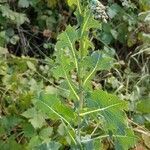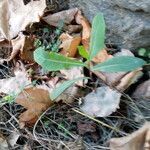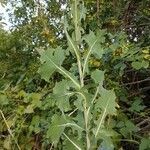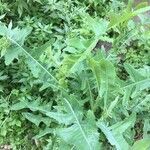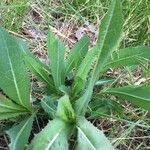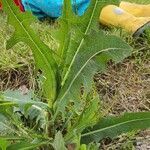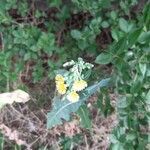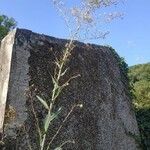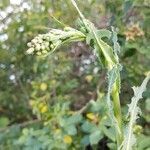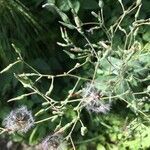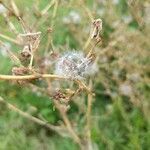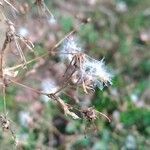Annuals or biennials to c. 2 m high, with lower stems and abaxial midrib of leaves prickly-setose, or less often stem glabrous, sometimes glaucous. Stem leaves to c. 20 cm long, with l:w ratio c. 4–8, divided or not; base above mid-stem sagittate, stem-clasping; margin spinulose-denticulate, often becoming ±smooth nearer summit; undivided leaves narrowly oblong; divided leaves with 1–3 broad retrorsely arching lobes or segments per side. Capitula many to c. 100; involucre 6–10 mm long, elongating to c. 15 mm long at maturity, c. 2 mm diam.; bracts reflexed at maturity; outer bracts 3–6, ovate, 1–2 mm long, lacking hyaline margin; longer intermediate bracts subequal to inner bracts at anthesis; inner bracts 4 or 5, with distinct hyaline margin. Florets: ligule 7–10 mm long; style hairs pale. Achenes 6–8 mm long; body c. 3 mm long; faces narrowly obovate, mid-brown, with minute whitish cilia distally; beak as long as or up to c. 30% longer than body. Pappus c. 6 mm long, white; bristles extremely fine, minutely scabridulous.
Leafy-stemmed annual or biennial, 3–15 dm, the stem often prickly below, otherwise glabrous; lvs prickly on the midrib beneath, and more finely prickly-toothed on the margins, otherwise generally glabrous, pinnately lobed or lobeless, commonly twisted at base to stand vertically, sagittate-clasping, oblong or oblong-lanceolate in outline, the upper much reduced; heads numerous in a long, often diffuse infl, with (13–)18–24(–27) light yellow fls, drying blue; invol 10–15 mm in fr; achenes gray or yellowish-gray, the body compressed, 3–4 mm, a third as wide, prominently several-nerved on each face, spinulose or hispidulous above at least marginally, the slender beak about equaling the body, rarely twice as long; 2n=18. A weed in fields and waste places; native of Europe, now naturalized throughout most of the U.S. July–Sept. The common form with lobeless lvs, called var. integrata Gren. & Gordon, may reflect introgression from L. sativa L., cultivated lettuce, with which L. serriola hybridizes freely. (L. scariola)
Biennial or perennial herb, up to 2 m high; plant with milky latex. Leaves alternate, sessile; blade up to 200 x 100 mm, broadly elliptic in outline, runcinate-pinnate, lateral lobes 2-6, recurved, apices rounded to obtuse mucronate, margins irregularly denticulate and ± sinuate-dentate, base sagittate-auriculate, auricles narrowly pointed, some leaves undivided, oblong-obovate; glabrous but midrib on lower surface often spinulose. Heads ligulate, many in lax, pyramidal panicle. Involucre 6-8 mm long and cylindric, increasing up to 13 x 3.5 mm in fruiting; involucral bracts in several series, imbricate. Flowers: pale yellow; Oct.-Jan. Fruit with cypsela pale or greyish brown, narrowly obovate, laterally compressed, up to 3 x 1 mm, broadly ribbed on margins, each face closely and equally ± 5-ribbed, hispidulous towards apices, with beak longer than body of cypsela. Pappus of many, white, barbellate bristles.
Glabrous biennial or perennial herb with one or several stiffly erect leafy stems to 2 m from a single crown, often prickly near the base. Leaves up to 20 x 10 cm, decreasing in size upwards, runcinate-pinnatifid, only the very topmost lanceolate and less deeply cut, base sagittate-amplexicaul, spinose-ciliate on the margins and prickly on the main veins below. Heads many in a large, loose pyramidal panicle with stiff, patent branches. Involucre up to 12 x 5 mm. Flowers pale yellow. Achenes c. 3 mm long with a 5 mm beak, narrowly obovate tapering sharply into the beak, strongly compressed, finely and evenly ribbed on both faces, greyish.
Erect annual or biennial herb, up to 2 m high, with milky latex. Leaves alternate, sessile, runcinate-pinnatifid, decreasing in size upwards, upper leaves lanceolate and less deeply cut, base sagittate-amplexicaul, margins spinose-ciliate, prickly on main veins below, otherwise glabrous. Capitula ligulate, many in a large, loose, pyramidal panicle with stiff branches; involucre up to 12 mm long. Florets pale yellow. Flowering time Nov.-Mar. Pappus of many barbellate bristles. Cypselae greyish, narrowly obovate, strongly compressed, each face closely and equally ribbed, tapering into a beak longer than body of achene.
A herb. It grows 1-2 m high. It takes 2 years to complete its life-cyle. It has a well developed taproot. The leaves have deep lobes and are bluish-green with a whitish bloom. They have prickly edges. The lower leaves form a ring near the ground. They are large and the higher leaves are smaller. The leaves are 3-18 cm long. The flowering stem is stiff and 1.5 m high. The flowers are small and yellow. There are prickles on the midrib of the leaves. The spiny stems ooze milky sap when cut. Variety scariola has leaves and lobes that are more narrow than Lactuca serriola.
Leaves ± appressed to the stem, sessile, usually up to 10 x 6 cm., exceptionally to 20 x 10 cm., broadly elliptic in outline and runcinate-pinnate, or some leaves undivided and oblong-oblanceolate; lateral lobes 2–6, narrowly to broadly oblong, recurved; apices rounded to obtuse mucronate; margins irregularly denticulate and ± sinuate-dentate; bases sagittate-auriculate, the auricle lobes up to c. 2 cm. long and narrowly pointed; lamina glabrous but midribs beneath often weakly to strongly spinulose.
Achenes pale-or greyish-brown; beaks paler, equalling or exceeding the achene in length; achene 3 x 1 mm., oblanceolate, somewhat laterally compressed, broadly-ribbed on the margins and narrowly c. 5-ribbed on each face, hispidulous towards the apices; pappus several-seriate of numerous white, barbellate setae c. 4 mm. long, free on the apically expanded beak.
Annual or biennial herb, up to 2 m high. Achenes up to 1 mm broad, each face closely and equally ribbed; beak longer than body of achene. Involucre up to 12 mm long. Flowers pale yellow.
Florets c. 14 per capitulum; corollas yellow, c. 9 mm. long, tubes slender, ± densely pilose about the mouth; ligules erect, c. 5 mm. long, lorate.
Synflorescences paniculate, divaricately branched; branches up to 23 cm. long, glabrous; capitula on slender, bracteate stalks up to c. 4 cm. long.
Stems solitary, robust, simple below and branching above, glabrous to ± densely spinulose in the lower part, sometimes strongly so, leafy.
Phyllaries glabrous, c. 2 mm. long outside increasing to c. 13 mm. long inside becoming narrowly lanceolate, margins becoming involute.
Involucre 6–8 mm. long and cylindric at time of flowering, increasing to 13 x 3.5 mm. and becoming conical in fruiting capitula.
An erect annual or biennial herb up to 2.5 m. tall.
